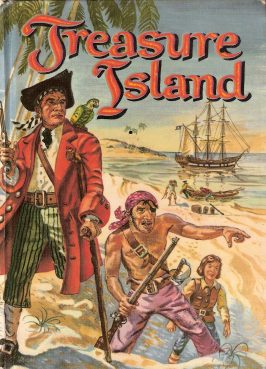
A chest full of gold pieces and a treasure map; a voyage to tropical waters on a ship packed with secret enemies; a mutiny complete with cannon fire; X marks the spot. It is the very model of a modern major pirate tale*. If you’ve had any pop cultural contact with pirates at all, you know the outline of this story, and all that remains is to fill in the details.
There was definitely a copy of this in my house growing up, so how did it take me thirty literate years to read it? At least part of the explanation lies in the fact that, as a child, I was an extreme girly girl, and pirates are undeniably dirty and gross; not to mention that the single female character in the novel only appears for a couple of chapters and is a mum (not at all interesting when you’re ten).
What was good and what was not? (Spoilers if you honestly don’t know the plot.) Well, mercifully, the voyage doesn’t really encounter any indigenous inhabitants of small islands, so we’re spared whatever degree of unenlightenment would otherwise have manifested in that respect (we don’t escape it entirely, but it could surely have been worse). There’s no denying that the book essentially consists of 200 pages of performative masculinity, so it’s a mercy that it doesn’t go on for too long. There is more nautical language than I cared to ascribe meaning to, but some was, I grudgingly suppose, necessary, and presumably kids in the 19th century might have had more understanding of that.
The protagonist, the cabin boy Jim, is a pretty resourceful and independent kid, and I can see how a pre-teen reader (of a different type than I was) would be inspired by him to daring deeds of derring-do. (Several times he saves the day by ignoring the adults; as an adult now myself, I can’t support him going off by himself against pirates, but it would definitely be attractive to a kid.) (The little girl that I was would never have left comfortable England in the first place, and good for her.)
Far and away the best character is Long John Silver, who has a parrot but NOT a wooden leg (he is missing a leg but just uses a crutch). He’s a through-and-through baddy, but even after Jim witnesses him kill a guy, he’s charismatic enough to negotiate a truce and get off the island with a chunk of the loot. He’s such an amoral opportunist that the liberal arts graduate in me feels Stevenson, born into and writing from the dark heart of industrial Britain, lost a prime opportunity to use him as a metaphorical critique of capitalism. What twelve-year-old wouldn’t love to read about that?
Consume with rum sipped from a coconut shell.
*As far as I can tell, these pirates are not from Penzance. But. You never know.
Trigger warning: general violence.